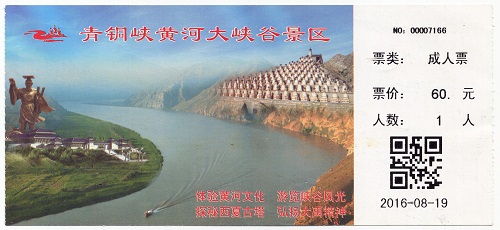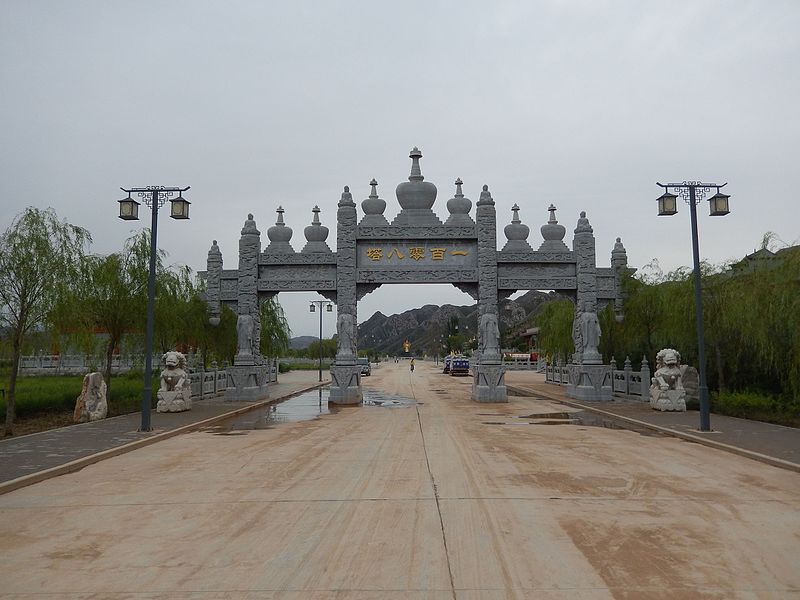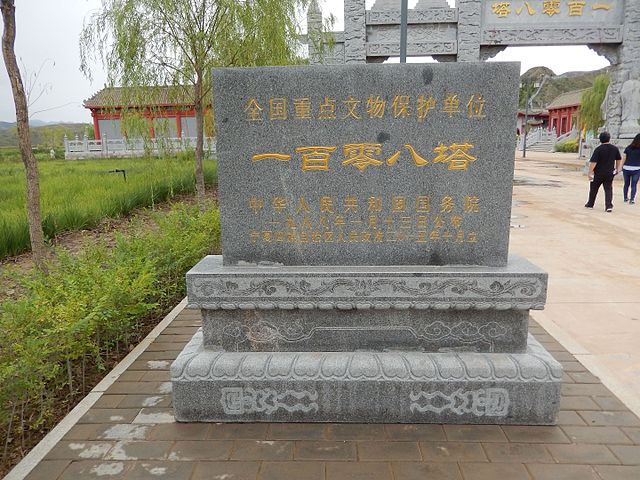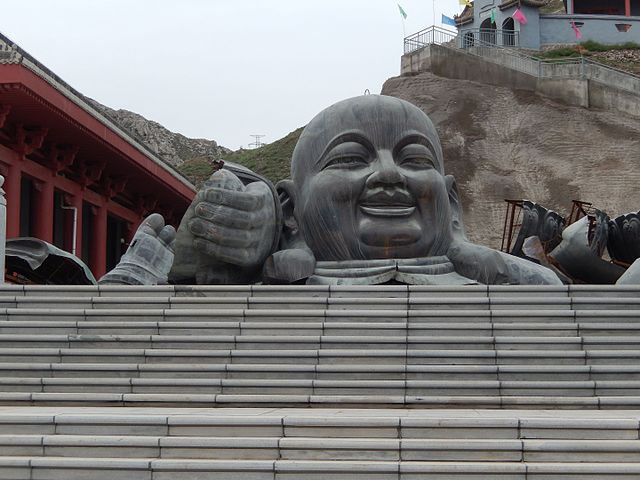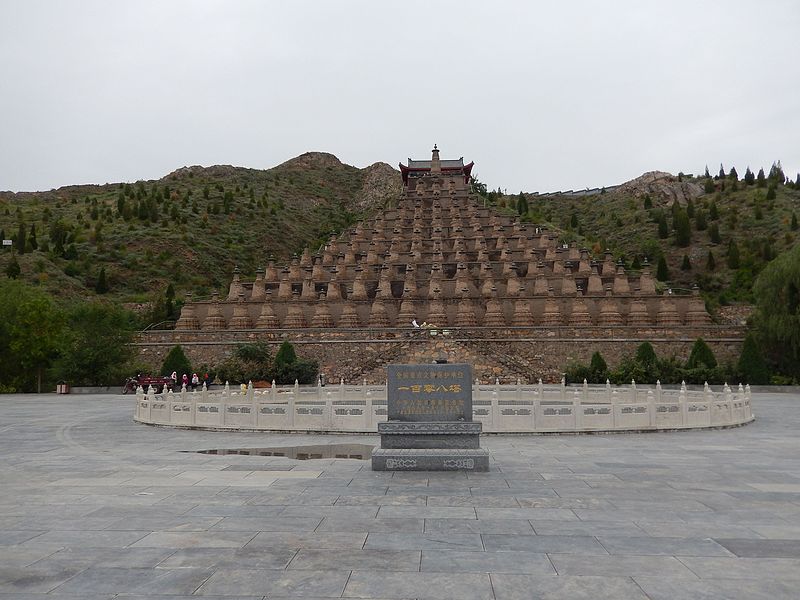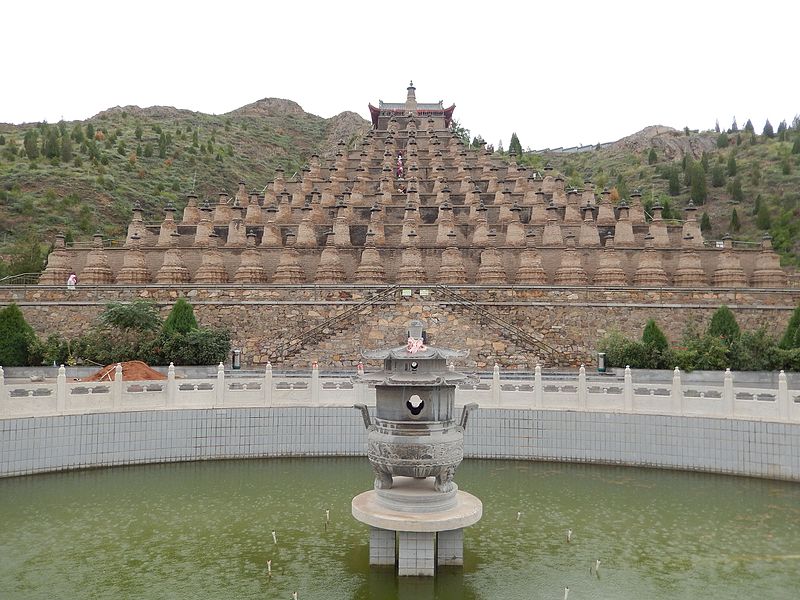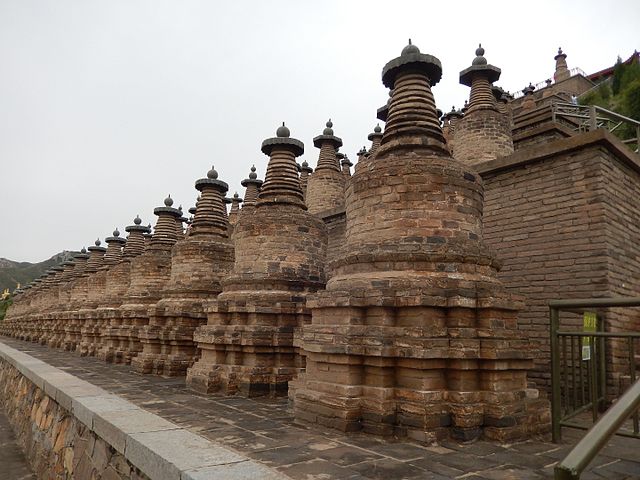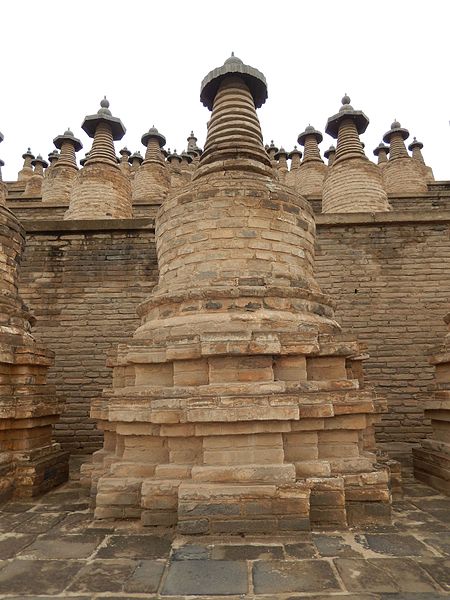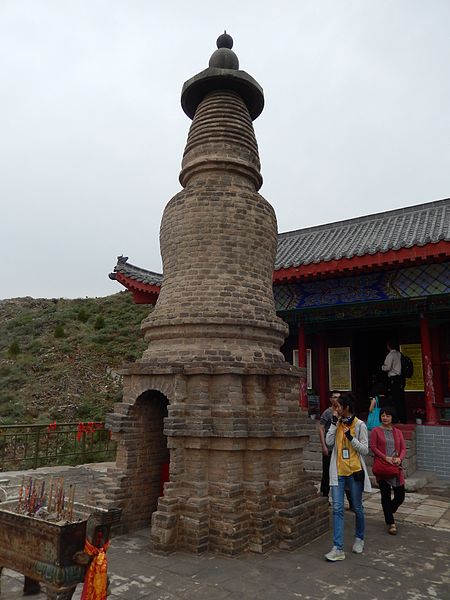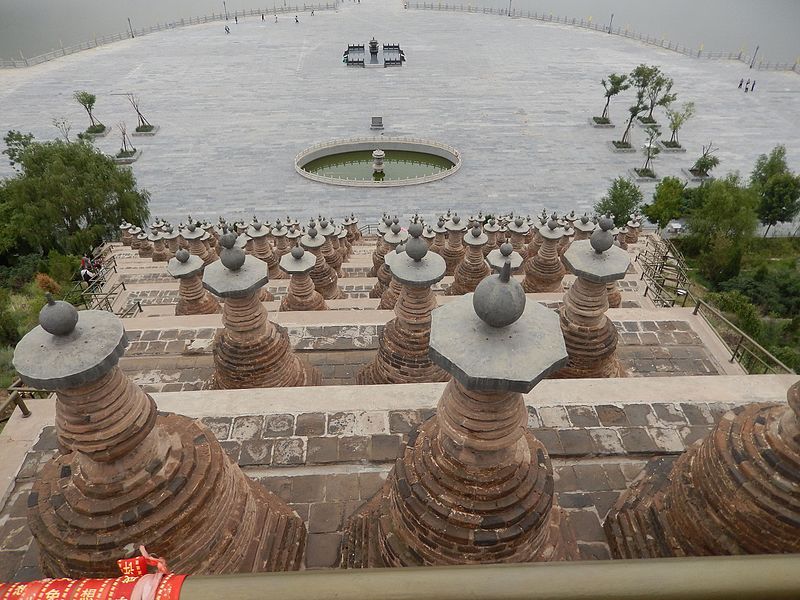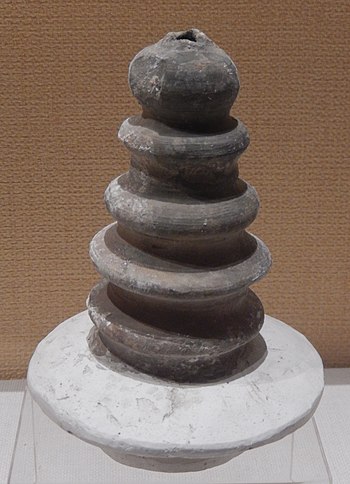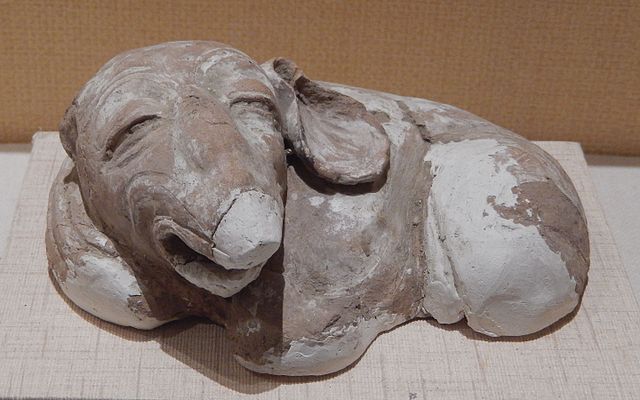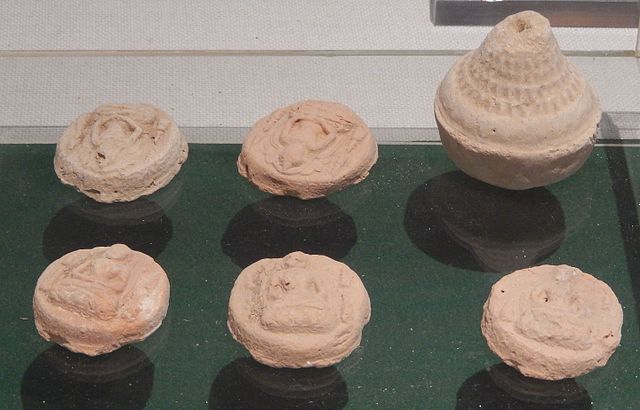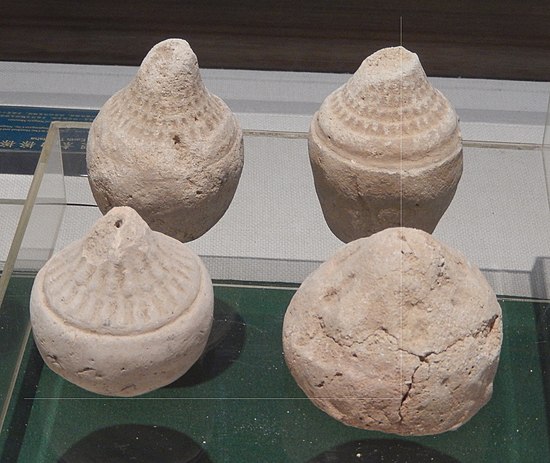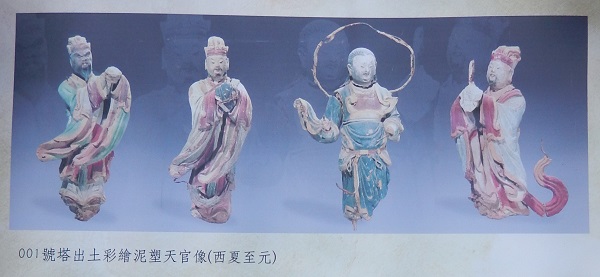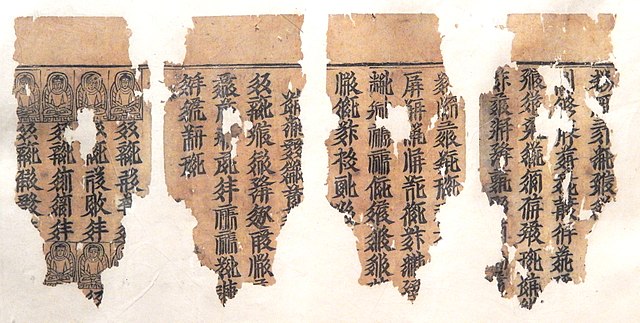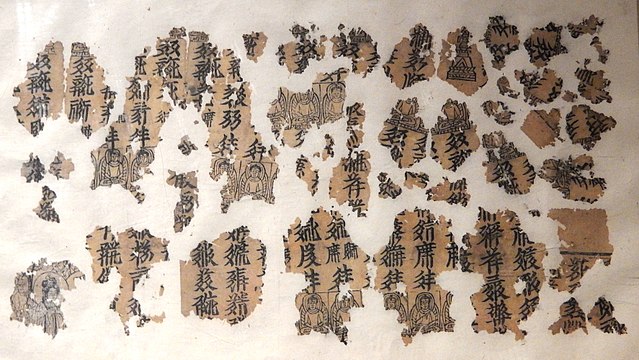Diary of a Rambling Antiquarian
Friday, 19 August 2016
108 Stupas
Today is my second full day in Ningxia, and as it is the day before the start of the two-day conference on encoding Khitan scripts in Unicode, we are all going on an excursion. We were originally scheduled to visit the Sand Lake 沙湖 scenic area 60 km north of Yinchuan, but it seems like a huge tourist trap, and I want to visit somewhere of historical and cultural interest, so I suggest that instead we visit the famous 108 Tangut stupas (一百零八塔 = 𘊝𘉋𗽔𘗣) about 90 km south of Yinchuan. These stupas are positioned on a hillside overlooking the Yellow River, about 20 km south of the city of Qingtongxia 青銅峽 ("Bronze Gorge"), and are the only surviving relics of an important Tangut Buddhist temple complex dating from the Western Xia period (1038–1227).
Entrance ticket for the Qingtongxia Yellow River Gorge Scenic Area
Like yesterday, it is a dreary and overcast day, with puddles lying across what appears to be a quite recently completed entrance road.
Entrance to the 108 Stupas
The obligatory pedestal tablet in front of the entrance arch informs us that the site of the 108 stupas was established as a Major Historical and Cultural Site Protected at the National Level (全國重點文物保護單位) in January 1988, and that the pedestal tablet itself was erected in October 2015, less than a year ago. As we walk further down the grey road we see newly-constructed and half-finished buildings, including a large exhibition hall and garishly gilded fake temples, along the hillside on our right. It seems that this once-secluded Buddhist retreat is in the process of being reconstructed as a major tourist attraction (although there are few tourists here today other than ourselves). A concrete-paved desert sprawls out as far as the eye can see, and not for the first time — and certainly not for the last — I ask myself why I did not visit this and other Tangut sites when I was studying in China in the mid 1980s, before they became commercialized and renovated beyond recognition.
Pedestal Tablet for the 108 Stupas
The dismembered parts of a giant Buddha statue laugh at us as we pass by.
Parts of a Giant Buddha Statue
The whole area has been completely remodelled over the last few years, and the road leads us to a series of three paved semi-islands set in an artificial lake between the hillside on our right and the Yellow River, just out of sight, on our left. The central and largest of these three islands faces onto the one hundred and eight stupas.
Google Maps Satellite View of the 108 Stupas
{Imagery ©2017 DigitalGlobe, Map data ©2017}
Standing on a brick platform 5 metres off the level ground, and climbing 32 metres up the side of the hill is the triangular array of one hundred and eight brick stupas facing southeast towards the Yellow River. A round balustraded pond is incongruously placed in the paved area in front of the 108 stupas, and in front of that another obligatory pedestal tablet reminding us of what we are looking at. It is only later that I find out that the pond lies over the site of the Western Xia Buddhist temple that these stupas were associated with (see below).
First View of the 108 Stupas
The one hundred and eight stupas form a triangle with a decreasing odd number of stupas on eleven terraces, and a single large brick stupa on a plateau at the top. The number of stupas on each row is: 19, 17, 15, 13, 11, 9, 7, 5, 5, 3, 3, 1.
In front of the 108 stupas
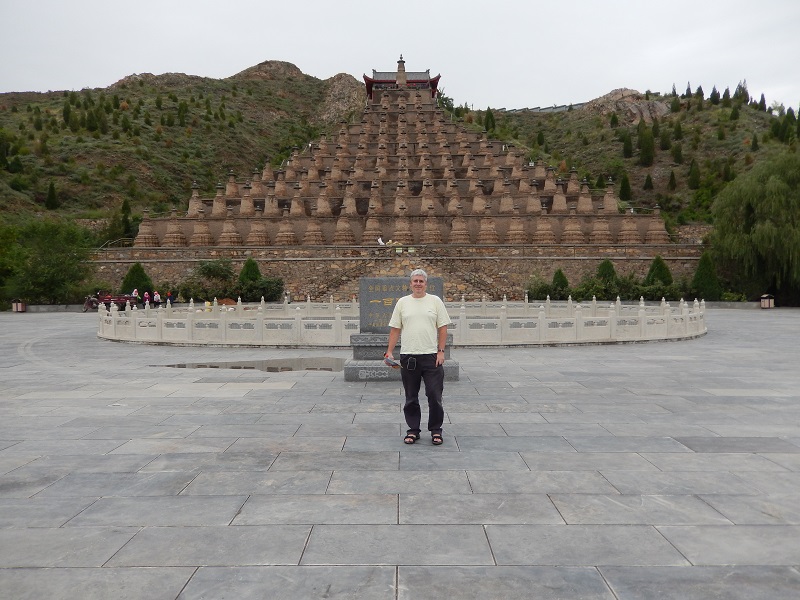
Present State of the 108 Stupas
The photographs below show what the 108 stupas look like today, after extensive preservation and reconstruction carried out during 1987 and 1988. At that time none of the stupas were complete, and many had been reduced to just a base, so the few relatively complete stupas were used as models to reconstruct the brickwork of the others.
108 Stupas in the Rain
The people you can see among the stupas are carrying out minor repairs to the terraces and stupas.
Bottom Row of 19 Stupas
The paved and bricked terraces that the stupas stand on are a modern feature created during the restoration of 1987–1988. The stupas were originally built directly on the hillside.
Closeup of a Single Stupa
There are several different designs of brickwork. The bottom row of 19 stupas and the large stupa at the top have a zigzag ratha-shaped base, whereas the remaining 88 stupas all have an octagonal base. Rows 1 and 12 (20 stupas), rows 2–6 (23 stupas), row 7 (9 stupas), and rows 8–11 (56 stupas) each have slightly different shapes of hemispherical domed stupa body. Whole bricks are used for the stupa base, and half-bricks are used for the body of the stupa. In 1987, before restoration, the stupas were 2.0–2.5 metres in height, with a diameter of 1.9–2.1 metres, but after renovation and the addition of a finial and canopy they are now somewhat taller.
Top Row of 3 Stupas
These stupas have an octagonal base.
The Large Stupa at the Top
There is a small opening on the east side of the large stupa, with a small room in the centre, currently occupied by a Buddhist statue and an offering box. There is a small Buddhist hall behind the stupa. In 1987, before restoration, the large stupa was 5.04 metres high, with a diameter of 3.08 metres, but it now somewhat taller.
In front of the large stupa
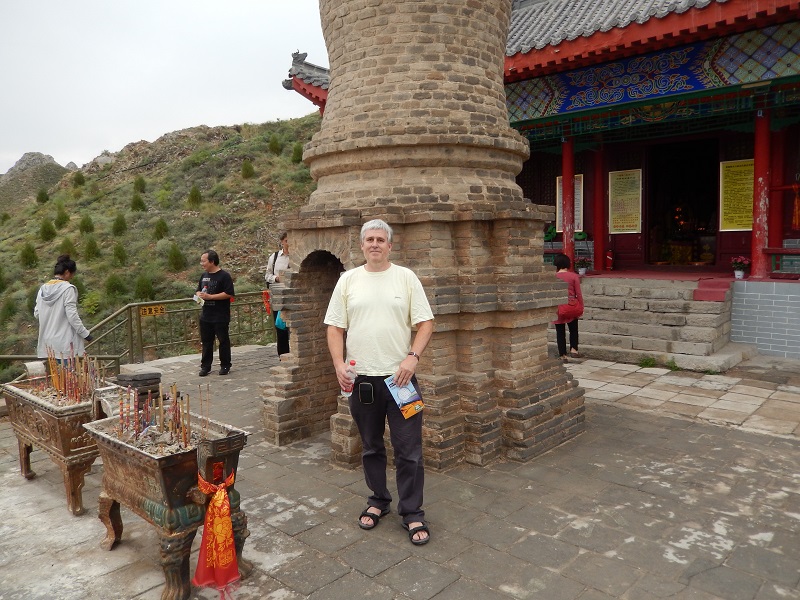
Looking Down from the Top
2017 update: The area in front of the stupas looks quite different now, as can be seen from this photograph dated 17 April 2017 (I think the photograph was taken then, but maybe it is an old photo that shows what the area looked like some time before I visited it in 2016):
Eight months later
Source: 中航国旅官网:青铜峡108塔.
History of the Stupas
The brick stupas standing on a series of bricked and paved terraces that we see today bear very little resemblence to what they originally looked like during the Western Xia period, or even what they looked like fifty years ago.
When the stupas were investigated in the 1950s the brick stupas were coated in a layer of white plaster which gave them a rotund shape. The stupas were in varying states of deteriation, and no finials or canopies survived on any of them. As can be seen from the photograph below, there was an additional stupa and the remains of a temple on the flood plain immediately in front of the 108 stupas, as well as a smaller stupa by the remains of a smaller building a little to the south. These remains indicate that the stupas were part of a larger religious complex.
Aerial View of the 108 Stupas in the 1950s
From a poster in the 108 Stupas Exhibition Hall
In 1958 construction started on a hydroelectric dam across the Yellow River only one kilometer downstream from the stupas. This dam would cause the the land between the river and the hillside to be flooded for several years, and so in 1958 the two stupas below the 108 stupas were archaeologically investigated and demolished. Two Western Xia period silk Buddhist paintings were discovered in these stupas (see below), and fragments of Tangut Buddhist texts, miniature terracota stupa models, and clay tsha-tsha were found in the vicinity of the temple (see below). The photograph below shows the stupas after the land beneath them had been flooded.
View of the 108 Stupas overlooking the flooded temple complex
From a poster in the 108 Stupas Exhibition Hall
It seems that no further investigation of the stupas was carried out until the mid 1980s. During 1987 and 1988 the stupas and surrounding area were comprehensively surveyed, and the stupas restored to their current brick form. At this time an octagonal brick platform which would have supported another stupa was found on the hillside just north of the 108 stupas. Fragments of Buddhist sutras written in the Tangut script were discovered in this platform, together with about a dozen clay stupa models.
The photograph below shows Masters students from Northwest Number Two Nationalities College 西北第二民族学院 (the predecessor of Beifang University of Nationalities) on a visit to the 108 stupas in 1986, shortly before they were reincarnated as brick stupas. By this time there is dry land in front of the stupas as the flooding due to the dam had long since ceased. However, all signs of the temple and stupa shown in the 1950s photograph have vanished.
Students in front of the 108 Stupas in 1986
Framed photograph at the Beifang University of Nationalities (北方民族大学) in Yinchuan
The architectural history of the stupas was reconstructed during their restoration in 1987. The original stupas were made of sun-dried mud bricks surrounding a central wooden supporting pillar. The mud brick core was coated in white plaster, with lotus flower designs or Sanskrit text painted in red around the base. Later, the stupa bases were strengthened, and additional mud was applied to reinforce the stupa body. The stupas were replastered twice during the Yuan and Ming dynasties. During the early Qing dynasty the stupas underwent a major renovation, and the dilapidated mud stupas were encased in brick to protect them. The brickwork was encased in a white plaster outer layer.
State of stupas before restoration in 1987
From a poster in the 108 Stupas Exhibition Hall
Early Qing brick casing over the original mud brick core
Stupa with an octagonal base on the left, and stupa with a Ratha-shaped base on the right.
From a poster in the 108 Stupas Exhibition Hall
The interior of a stupa after the Qing dynasty brick casing had been removed
From a poster in the 108 Stupas Exhibition Hall
Sanskrit writing on the base of the original mud core
From a poster in the 108 Stupas Exhibition Hall
Lotus flower designs painted on the base of the original mud core
From a poster in the 108 Stupas Exhibition Hall
No datable material has been found in any of the 108 stupas, but as Western Xia paintings were found in the two stupas below the 108 stupas, and Tangut Buddhist texts were recovered from the octagonal stupa base north of the 108 stupas, it is probable that the 108 stupas were originally constructed during the Western Xia period. Some printed books from the Western Xia period include drawings of stupas, which give us some idea of what Western Xia stupas would have looked like. The image of a stupa from a woodblock printed edition of the Tangut translation of the Names of the Buddhas Sutra 佛名經 (Buddhanāma) shown below is a good example. The design on the base is very reminiscent of the lotus flower design shown in the above image, and the curved body of the stupa suggests that it was covered in a plaster coating, and painted with a chevron-shaped design.
Tangut printed text with a drawing of a stupa
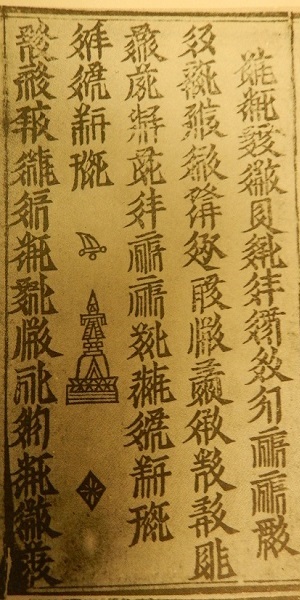
Eric Grinstead, The Tangut Tripitaka (New Delhi, 1971) vol. 4 p. 913
The Tangut word for "stupa" is mbə ndu 𗽔𘗣.
The restoration during 1987–1988 involved the removal of the plaster coating, and rebuilding of the Qing dynasty brickwork encasing the original mud brick core. This reconstructed early Qing brickwork is what we see today. Although what we see today are not the original Western Xia stupas, and even as reconstructed Qing stupas they are not entirely authentic, they still have a certain charm, and I am very glad I managed to see them today.
Artefacts and Texts found at the 108 Stupas
Here are some of the artefacts and texts that were found at the 108 stupas and associated temple complex. Some photos of objects found here were taken by me on my visit to Ningxia Museum in Yinchuan yesterday; some are my photos of posters on display in the 108 Stupas Exhibition Hall. The 108 stupas are numbered from the large stupa at the top (No. 1) downwards to the bottom.
Pottery stupa finial found in Stupa No. 101
Three hollow pottery stupa finials (Chinese tǎ chà 塔剎), one with traces of red paint on it, varying is height from 13.0 cm to 17.0 cm, were found in Stupa Nos. 101 and/or 108 (sources vary as to which).
Clay elephant statue
Possibly the base for a statue of the bodhisattva Samantabhadra.
Tsha-tsha, which are small clay tablets with impressed images of buddhas and bodhisattvas, and miniature clay models of stupas or pagodas are commonly found at Western Xia Buddhist sites, and in some locations hundreds or even thousands have been found. The 108 stupas are no exception, and during the 1980s renovations over a hundred minature "stupas" (they don't look much like stupas to me), between 5.0 cm and 12.5 cm in height, were found, as well a number of tsha-tsha with impressed images of Buddhas or bodhisattvas.
Five clay tsha-tsha with Buddha images and a clay stupa model
Four clay tsha-tsha stupa models
Four colour painted pottery sculptures of heavenly officials from Stupa No. 1
Three brick sculptures of Buddhist figures from Stupa No. 85
From a poster in the 108 Stupas Exhibition Hall
Brick sculpture of a Buddhist figure from Stupa No. 17
From a poster in the 108 Stupas Exhibition Hall
The two images below show fragments of the Tangut version of the Thousand Names of the Buddha of the Present (𗌮𗫻𗾈𗑱𗡞𗢳𗦻𗖰𗚩 = 現在賢劫千佛名經). These were found in the octagonal brick platform for a lost stupa to the north of the 108 stupas, and are currently on display at Ningxia Museum.
Fragments of a Tangut Buddhist text
The silk painting of a Thousand Buddhas shown below (apologies for the poor quality) was found in the "No. 2 stupa" below the 108 stupas (I assume the No. 2 stupa is the one further to the south). The painting is typical of the Western Xia style of Buddhist silk paintings.
Silk painting of a Thousand Buddhas
From a poster in the 108 Stupas Exhibition Hall
Ningxia | Stupas | Western Xia
Index of Rambling Antiquarian Blog Posts
Rambling Antiquarian on Google Maps
